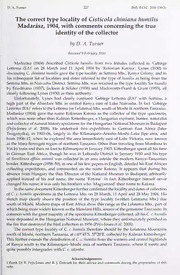
The Correct Type Locality of Cisticola Chiniana Humilis Madarasz, 1904, with Comments Concerning the True Identity of the Collector PDF
Preview The Correct Type Locality of Cisticola Chiniana Humilis Madarasz, 1904, with Comments Concerning the True Identity of the Collector
D. A. Turner 227 Bull. B.O.C. 2010 130(3) The correct type locality of Cisticola chiniana humilis Madarasz, 1904, with comments concerning the true identity of the collector by D. A. Turner Received9February2010 Madarasz (1904) described Cisticola humilis from two females collected in 'Gebirge Lettema (EA)' on 28 March and 11 April 1904 by 'Koloman Katona'. Lynes (1930) in discussing C. chiniana humilis gave the type locality as Settima Mts., Kenya Colony, and in his subsequent list of localities and dates referred to the type of humilis as being from the Settima Mts. in Naivasha District. Settima Mts. was retained as the type locality for humilis by Friedmann (1937), Jackson & Sclater (1938) and Mackworth-Praed & Grant (1955), all clearly following Lynes (1930) as their authority. Unfortunately, Lynes had clearly confused 'Gebirge Lettema (EA)' with Settima, a high part of the Aberdare Mts. in central Kenya east of Lake Naivasha. In fact 'Gebirge Lettema (EA)' referstotheLettema (orLelatema)Mts. southofMoshiinnorthernTanzania. Madarasz (1904) gave the name Koloman Katona as the collector of the type specimens, which was none other than Kalman Kittenberger, a Hungarian explorer, hunter, naturalist andcollectorofnaturalhistoryspecimensfortheHungarianNationalMuseuminBudapest (Prys-Jones et al. 2008). He undertook two expeditions to German East Africa (later Tanganyika), in 1903-06, largely in the Kilimanjaro-Arusha-Moshi-Lake Jipe area, and from 1908-12, when he explored the area immediately east of Lake Victoria, now known as the Mara-Serengeti region ofnorthern Tanzania. Other than traveling from Mombasa to Voibytrainand thenonfootto Kilimanjaro inJanuary 1903, Kittenberger spentallhis time in German East Africa, though he was in Loliondo District in January 1910 and his type of Sarothrura affinis antonii was collected in an area astride the modern Kenya-Tanzanian border. Kittenberger (1958-59),inoneofhisfewpapersinEnglish, detailedhisEastAfrican collecting expeditions, and commented on the name Katona. It appears that during his absence from Hungary the then Director of the National Museum in Budapest, arbitrarily applied instead of his real name, the name 'Katona'. In fact, Kittenberger himself never changed his name; itwas onlyhis brothers who 'Magyarized' theirname to Katona. InthesamedocumentKittenbergerfurtherconfirmedthelocalityanddatesofcollection of C. c. humilis specimens as the Lettema Mts. on 28 March, 11 April and 28 May 1904. His sketch map clearly shows the position of the type locality (written Letatama Mts.) due south ofMoshi. Modern maps of East Africa show this range as the Lelatema Mts., part of whichbeingmorewidelyknownastheMerelaniHills,sourceofthegemstoneTanzanite.In commonwiththegreatmajorityofthe specimensKittenbergercollected, allhis C. c. humilis were deposited in the Hungarian National Museum, where they unfortunately perished in the fire that destroyed thebird collection in 1956 (Prys-Jones etal. 2008). The correct type locality of C. c. humilis therefore should be the Lelatema Mountains south ofMoshi, northern Tanzania, at c.03°45'S, 37°20'E, collected by Kalman Kittenberger. This furtherextends the distributionofC. c. humilis fromthewestern and centralhighlands of Kenya south to the Kilimanjaro-Moshi area of northern Tanzania, where it meets and quite possibly intergrades with C. c. ukamba. Acknowledgements I thank Dr R. Prys-Jones and R. J. Dowsett for their advice and comments during the preparation of this note. D. A. Turner 22S BuU. B.O.C. 2010 130(3) References: — Friedmann, H. 1937. Birds collected b\j the Childs Frickexpedition to Ethiopia & Kenya Colony. Part2 Passeres. SmithsonianInstitution,WashingtonDC. Jackson, F. J. & Sclater, W. L. 1938. Tlie birds ofKenya Colony and the Uganda Protectorate, vol. 2. Gurney & Jackson,London. Kittenberger,K. 1958-59.MyornithologicalcollectingexpeditionsinEastAfrica.Aqnila65: 11-37;66: 53-87. Lynes, H. 1930.ReviewofthegenusCisticola.Ibis12(6) (Suppl.): 1-673. Mackworth-Praed,C.W. &Grant,C.H. B. 1955.Africanhandbookofbirds:easternandnorth-easternAfrica,vol. 2. Longmans,London. Madarasz,G. 1904.CisticolahumUisn.sp.Orn.Monatsb.12: 168. Prys-Jones, R., Fuisz, T. I. & Willard, D. 2005. An unfortunate and neglected collector ofAfricanbirds. Pp. 59-80 in Faczanyi, O. (ed.) Commemorationfor Kdlmdn Kittenberger. Memorial meeting in the Hungarian AcademyofSciences. OrszagosMagyarVadaszkamara,Budapest. [InHungarianandEnglish.] Address: P.O. Box 1651,Xaivasha20117,Kenya. ©BritishOrnithologists' Club2010 Merops oreobates (Sharpe 1892): a monotypic species or not? by D. A. Turner Received9February2010 Prior to Fry's (1969) major contribution on the evolution and svstematics of bee- eaters, it had been generally accepted by most authors including Jackson & Sclater (1938), Chapin (1939), Peters (1945), Boetticher (1951) and White (1965) thaMt Cinnamon-chested Bee-eaterMerops oreobates (Sharpe 1S92) isnothingmorethan arace of lafresnayiiGuerin- Meneville, 1S43. However, Grant & Mackworth-Praed (1937) had considered (mainlv on morphological grounds) that lafresnayii more closely resembles Blue-breasted Bee-eaterM. variegatus Yieillot, 1817, than M.l. oreoMbates, and had proposed that lafresnayiibe considered a race of variegatus, thereby leaving oreobates a distinct monotvpic species of the East African highlands. This position was subsequently followed bv Mackworth-Praed & Grant (1952) but clearly rejected by White (1965). More recently, Fry (1984), Fry et al. (1988), Fry (2001) and Dickinson (2003) have all followed Grant & Mackworth-Praed (1937) and Fry (1969) in considering lafresnayii a race of variegatus. Throughout the greater part ofits range in West, Central and East Africa,Al. variegatus is a bird of damp lowland grassland and lakeside vegetation (Chapin 1939, Benson et al. 1971, Button 1980, Zimmerman et al 1996, Dowsett et al. 2008), but the subspecies M. v. bangweoloensis does reach 2,000 m in swampy areas of the Ufipa Plateau, south-west Tanzania (D. Mover & R. j. Dowsettpers. comm.). ThisisindirectcontrastwithAl. oreobates, which throughout its rangeis a montanespeciesofopen forest, forestedgesandwoodlands at l,h00-2,300 m (Zimmerman et al. 1996). In Ethiopia lafresnayii is largely confined to the m Rift Valley and adjacent highlands, favouring a variety offoresthabitatsbetween530 and 1,830 m (Ash & Atkins 2009). Morphologically, lafresnayii is intermediate between variegatus and oreobates, being closer to the former in coloration, but nearer the latter in size and habitat preference. Vocalisations of lafresnayii are reportedly identical to those of oreobates but totally unlike variegatus (B. Finch pers. comm.). In Chappuis (2000) some vocals of variegatus are either a rather hard Hup, Hup, or slightly softer and more prolonged (e.g., a pair displaying), in contrast to the vocals oforeobates which are much higher pitched. Van Someren (1922) had commented thatspecimensoforeobates from theTurkwell (Gorge) area ofnorth-westKenya are sometimes very like Ethiopian birds, having the blue forehead, supercilium and neck-
